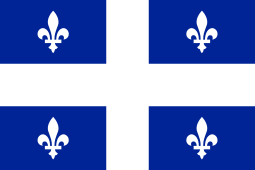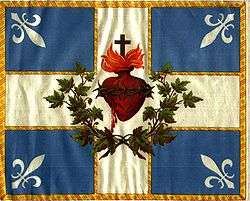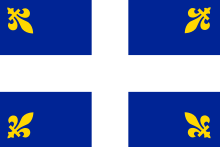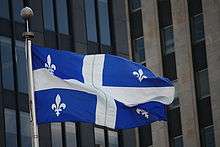Flag of Quebec
 | |
| Name | Fleurdelisé |
|---|---|
| Use | Civil and state flag |
| Proportion | 2:3 |
| Adopted | January 21, 1948 |
The flag of Quebec, called the Fleurdelisé, was adopted for the province by the government of Quebec, during the administration of Maurice Duplessis. It was the first provincial flag officially adopted in Canada, first shown on January 21, 1948, at the Parliament Building of the National Assembly in Quebec City. Quebec's Flag Day (January 21) commemorates its adoption each year, though for some time it was celebrated in May.[1] At least one parade marked the flag's 60th anniversary in January 2008.[2]
Status
Article 2 of An Act respecting the flag and emblems of Québec confers the status of "national emblem" to the flag of Québec.[3][4]
Symbolism
The Fleurdelisé takes its white cross from the ancient royal flags of France.
Its white fleurs-de-lis (symbols of purity) and blue field (symbolizing Heaven) come from a banner honouring the Virgin Mary. One such was reputedly carried by French Canadian militia at General Louis-Joseph de Montcalm's victory at Carillon.
The flag is blazoned Azure, a cross between four fleurs-de-lis argent. Its horizontal symmetry allows both sides of the flag to show the same image.
Protocol
.svg.png)
The flag's official ratio is 2:3 (width to length), but the flag is very often seen as a 1:2 variant to match the flag of Canada in size when flying together.
The Act concerning the flag and emblems of Quebec states that "in all cases, the flag of Quebec has precedence over any other flag or emblem."[5] However, under federal protocol, the Canadian flag takes precedence when both are flown.[6] When a federalist party controls the National Assembly of Quebec, both the flag of Quebec and the flag of Canada are displayed on either side of the President's dais, whereas when a sovereigntist party controls the chamber, only the Quebec flag is displayed.
The official shade of blue is Pantone 293. In 8-bit RGB, it is # 003399.[7] Unofficial variants using a lighter blue are common.[8]
History
.svg.png)
The desire of French Canadians in Quebec for a distinctive flag was longstanding. Other flags that had been used included the Parti Patriote flag, a horizontal green, white, and red tricolour, which became the flag of the Saint-Jean-Baptiste Society; as well as the French tricolour.
The direct predecessor of the modern Fleurdelisé was created by Elphège Filiatrault, a parish priest in Saint-Jude, Quebec. Called the Carillon, it resembled the modern flag except that the fleurs-de-lis were at the corners pointing inward. It was based on an earlier flag with no cross and with the figure of the Virgin Mary in the centre.
The Carillon flag was first raised on September 26, 1902, and is preserved in the Saint-Hyacinthe, Quebec archives. Another version, with the Sacred Heart in the centre, also appeared, but was left behind in the push for a new provincial flag after World War II. The Carillon flags were used informally.
On May 26, 1868, Queen Victoria approved Quebec's first coat of arms. A flag might have been devised by using the arms to deface a blue ensign (a Union Flag in the canton, and the Quebec coat of arms in the fly). However, it appears to have never been used — various sources including the official Quebec government site[9] mention that it was the Union Flag that flew over the Parliament Building until January 21, 1948, not the blue ensign. In addition, in 1938, at the opening of a mining school in Val-d'Or, the flag used to represent the Quebec government was a banner of arms. This was done at the behest of public servant Burroughs Pelletier,[10] who had been told that the Ministry wanted a symbol but were unsure as to what should be used.




In 1947, an independent member of the Legislative Assembly, René Chaloult, demanded a new provincial flag to displace the unpopular (amongst some segment of the population of Quebec) Canadian Red Ensign and replace the neglected Quebec blue ensign in the province. Various ideas were discussed between Chaloult, Lionel Groulx, and Maurice Duplessis. One such idea involved incorporating a red maple leaf (later to be adopted for the flag of Canada). Burroughs Pelletier was also asked to present a few projects to Duplessis, none of which were adopted. He was however asked to give advice as to what he thought about what became the current design.
On January 21, 1948, the new flag was adopted and was flown over the Parliament Building that very afternoon. Apparently, it was the Carillon flag that flew that day, because the modern Fleurdelisé (with the fleurs-de-lis repositioned upright to their modern configuration in correspondence with the rules of heraldry) was not available until February 2.[11]
The flag was adopted by Royal Proclamation, and the news was presented to the Legislative Assembly more or less as a fait accompli. Opposition leader Adélard Godbout expressed his approval, as did René Chaloult. A law governing the usage of the flag was later officially adopted by the Quebec Parliament on March 9, 1950. A more recent version of such a law was adopted in 2002.
A 2001 survey by the North American Vexillological Association ranked the Fleurdelisé as the best provincial or territorial flag, and the third-best of the flags of all U.S. and Canadian provinces, territories, and states.[12]
The flag of Quebec was the basis for the jerseys of the Quebec Nordiques, which included the same colour blue, the fleurs-de-lis, and white stripes.
Similar flag
![]() Flag of Georgia (country)
Flag of Georgia (country)
![]() Flag of Martinique
Flag of Martinique
See also
- Coat of arms of Quebec
- Flag
- List of Canadian provincial and territorial symbols
- Symbols of Quebec
- Timeline of Quebec history
- Flag of Martinique - Based on same motif
Notes
- ↑ Flag and emblems of Québec, An Act respecting the, R.S.Q. c. D-12.1
- ↑ Motor parade through the streets of Quebec City. CTV Newsnet broadcast, Jan. 20, 2008.
- ↑ National Flag and Emblems on the Government of Quebec's website, retrieved on May 17, 2009.
- ↑ "An Act respecting the Flag and emblems of Québec, R.S.Q. c. D-12.1", in CanLII. Federation of Law Societies of Canada, retrieved August 10, 2010
- ↑ Flag and emblems of Québec, An Act respecting the, R.S.Q. c. D-12.1
- ↑ Federal protocol gives precedence to the Canadian flag over provincial ones, and to the flags of the Governor General, 10 Lieutenant-Governors and some 24 members of the British-based royal family over the Canadian flag, when they are present at a specific location.PCH.GC.ca
- ↑ Normes d’utilisations / Signature du gouvernement du Québec
- ↑
- ↑ Le drapeau national - Histoire
- ↑ Father of Jean Pelletier
- ↑ Bouvier, Luc. "Histoire des drapeaux québécois: du tricolore canadien au fleurdelisé québécois", in HeraldicAmerica, retrieved May 19, 2008
- ↑ North American Vexillological Association News - Issue #170
References
In English
- ANQ. "An Act respecting the Flag and emblems of Québec", in CanLII. Federation of Law Societies of Canada, Updated to 1 May 2008
- MRIQ. "Québec flag protocol", in the site of the Ministère des Relations internationales, 2006
- Fraser, Alistair B. "Chapter XV: Quebec", in The Flags of Canada, January 30, 1998
In French
- Gouvernement du Québec. "Le fleurdelisé : reflet de notre histoire en Amérique", in the site Drapeau et symboles nationaux of the Government of Québec, updated on January 14, 2008
- Le Drapeau national: historique et protocole d'utilisation. [Québec, Qué.]: Relations avec les citoyens et immigration, Gouvernement du Québec, 2001. N.B.: Imprint and date appear on a sticker at end of the document.
- Bouvier, Luc. "Histoire des drapeaux québécois: du tricolore canadien au fleurdelisé québécois", in HeraldicAmerica (first published in l'Héraldique au Canada in 1994 and L'Action nationale in 1996)
- Tremblay, Joël and Gaudreau, Serge. "21 janvier 1948 - Adoption par l'Assemblée législative du fleurdelisé comme drapeau officiel du Québec", in Bilan du siècle, Université de Sherbrooke, May 18, 2005
- Bureau de normalisation du Québec (2004). Drapeau du Québec, Sainte-Foy: Bureau de normalisation du Québec, 24 pages
- Gouvernement du Québec (1998). Le cinquantième anniversaire du fleurdelisé, Québec: Commission de la Capitale nationale du Québec, 23 pages
- Bizier, Hélène-Andrée, Paulette, Claude, Fleur de lys : d'hier à aujourd'hui, Montréal : Art global, 1997, 152 pages
- Robitaille, René (August 1983). Le Drapeau de Carillon réalité historique ou légende, Québec: Société Saint-Jean-Baptiste de Québec, 34 pages
- Archambault, Jacques et Lévesque, Eugénie, Le Drapeau québécois, Québec: Éditeur officiel du Québec, 1974, 78 pages
- BnQ (1973). Bibliographie sur le drapeau du Québec : le fleurdelysé, Bibliothèque nationale du Québec (Centre bibliographique)
- Magnan, Charles-Joseph (1939). Le Carillon-Sacré-Coeur, drapeau national des Canadiens français, Québec : l'Action catholique, 44 pages (edition digitized by the BAnQ)
External links
| Wikimedia Commons has media related to Flag of Quebec. |
- Quebec at Flags of the World
- Proposals for a flag of Quebec, 1900–1902
- Proposals for a flag of Quebec, 1903–1904 Various versions of the Carillon flag
- Arms and flag of Quebec in the online Public Register of Arms, Flags and Badges
